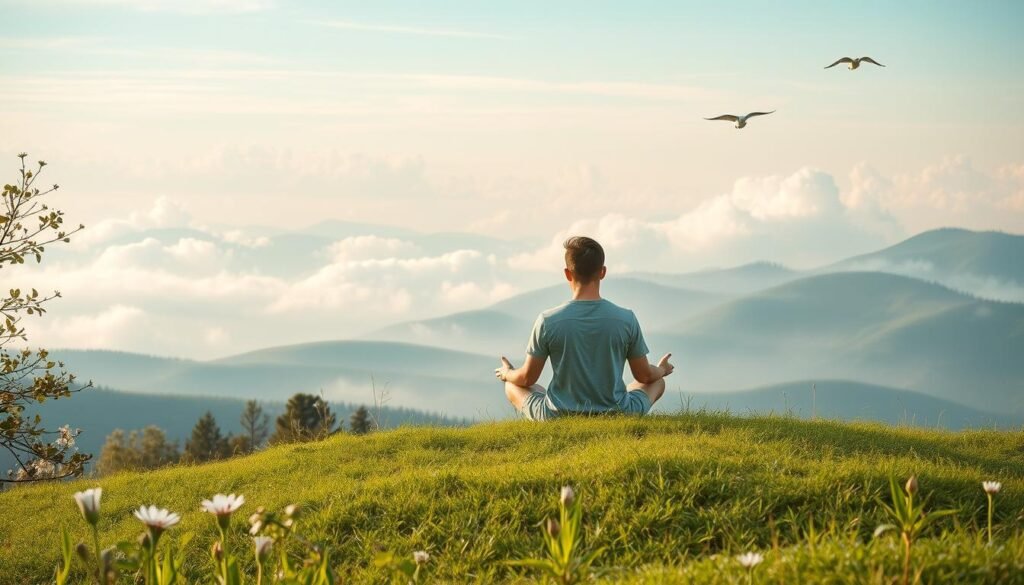About 2-3% of Americans face panic disorder every year. This fact shows the need for good anxiety relief methods. Using examining your surroundings can help control an anxiety attack. Looking around mindfully lets people refocus and calm their thoughts. This article talks about how noticing your environment helps manage anxiety. It also brings a big sense of peace in tough times.
Key Takeaways
- Panic attacks typically peak within 10 minutes before symptoms start to subside.
- Environmental awareness can greatly enhance anxiety relief and management.
- Regular engagement with nature improves overall well-being and contributes to calming effects.
- Practicing mindfulness helps ground individuals in the present moment during anxious episodes.
- Effective coping mechanisms can significantly lower the frequency and intensity of anxiety attacks.
Understanding Anxiety Attacks
Anxiety attacks can be quite overwhelming. They tend to come on suddenly. This creates a strong sense of fear and unease. While similar to panic attacks, anxiety attacks are different. It’s important to know these differences. This helps in correctly identifying and managing these episodes. Knowing what situations can cause these feelings helps people deal with their anxiety better.
What is an Anxiety Attack?
Anxiety attacks come from ongoing worries about certain events or potential problems. They grow slowly unlike panic attacks that hit suddenly. Anxiety attacks also stay longer. For people with generalized anxiety disorder (GAD), anxiety attacks are common and can be triggered by stressors like work or money problems. Social anxiety disorder can also lead to anxiety attacks during social events.
Common Symptoms of Anxiety Attacks
The symptoms of anxiety attacks include both emotional and physical reactions. Common ones are:
- Excessive worry about everyday situations.
- Restlessness and trouble focusing.
- Physical symptoms like changes in heart rate and muscle tension.
- Feelings of extreme fear or doom.
The symptoms can look similar to those of panic attacks. This often causes confusion. Having many anxiety attacks can lead to panic disorder. This is where you constantly worry about having more attacks. Recognizing symptoms early is key. It allows for better coping strategies and finding the right treatment quickly.
| Symptom | Description |
|---|---|
| Excessive Worry | Persistent concerns about different parts of everyday life. |
| Restlessness | Finding it hard to relax or be still, feels jittery. |
| Physical Changes | Heart rate changes, sweating, and other body reactions. |
| Feelings of Doom | Feeling like something bad will happen without knowing why. |
The Importance of Environmental Awareness
Being aware of our environment can help us handle stress better. Our emotional states are deeply tied to our surroundings, especially during stressful times. Knowing how our environment affects our anxiety is key to feeling calmer.
How Surroundings Impact Anxiety Levels
Studies show that nature lowers anxiety. It can make you feel better by lowering blood pressure and stress hormones. It also boosts mood and self-esteem.
People who spend time in green spaces each week tend to feel happier. It’s crucial to have spaces that help us relax. This shows how our surroundings play a big role in our mental health.
The Concept of Mindful Presence
Mindful presence means being fully aware of where you are. It helps you live in the moment. Paying attention to nature helps clear your mind.
Focusing on nature’s beauty can calm you down. It helps you handle stress better. This way, you can find peace amidst chaos.
Examining Your Surroundings Can Help Calm
Learning to use the environment during anxiety moments can greatly reduce panic attack symptoms. Grounding techniques are key in helping people focus on what’s around them. They not only increase awareness but also shift attention from intense emotions to the safety of now.
Grounding Techniques for Panic Attacks
Grounding techniques help people connect their minds with the outside. They involve simple actions like spotting objects around or focusing on sounds. These tasks engage the senses, making a link to reality that helps fight panic attack confusion. For details on nature’s mental health benefits, see this study.
Using Sensory Grounding to Ease Anxiety
Sensory grounding uses specific senses to relax. One way is using items like smooth stones or smelling essential oils. These sensory items prompt calm reactions, helping to stay present and reduce anxiety thoughts. Seeing natural scenes like plants or water adds to the calming, easing emotional upset as one recovers from stress.
Utilizing the 5-4-3-2-1 Method
The 5-4-3-2-1 method is a great way to ease anxiety by focusing on our senses. It connects us to the present by paying attention to what we feel, see, and hear. This method helps calm the nervous system when anxiety or panic hits.
Step-by-Step Guide to the 5-4-3-2-1 Method
Here’s how to use the 5-4-3-2-1 method:
- Five things you can see: Look around and name five items. Notice their colors and shapes.
- Four things you can hear: Listen for four sounds. This could be anything from birds to people talking.
- Three things you can touch: Feel three objects. They can be anything like your clothes or a chair.
- Two things you can smell: Find two scents nearby. It could be food or flowers.
- One thing you can taste: Focus on a taste in your mouth, maybe from your last meal.
Benefits of Sensory Focus During Anxiety
Using the 5-4-3-2-1 method brings big benefits for anxiety. It relaxes you and turns on the parasympathetic nervous system. This helps stop the fight-or-flight response that anxiety triggers.
Doing this regularly improves attention and thinking skills. It also keeps negative thoughts away. It helps you worry less and feel better overall. Mindfulness decreases anxiety and depression, making techniques like the 5-4-3-2-1 crucial for everyday life.

Deep Breathing as a Calming Strategy
Deep breathing is a key way to calm down when feeling anxious. By taking slow, controlled breaths, you can fight off the fast breathing that comes with panic. The 4-7-8 breathing method is easy and popular. You breathe in for 4 seconds, hold it for 7 seconds, and breathe out for 8 seconds. Such methods relieve anxiety and help you feel relaxed.
Benefits of Deep Breathing Techniques
Deep breathing does more than just help with anxiety in the moment. Some benefits are:
- Improving heart and lung function
- Reducing blood pressure
- Enhancing overall quality of life
- Decreasing frequency and severity of migraine attacks
- Aiding in faster sleep onset
A study in 2020 showed many people feel less anxious and more relaxed after deep breathing. Just five minutes can slow your heart rate and bring peace.
How to Practice Deep Breathing
Starting with deep breathing is easy and anyone can do it. First, find a cozy spot to sit or lie down. Then:
- Inhale deeply through the nose for 4 seconds, letting your belly rise.
- Hold the breath for 7 seconds, and enjoy the calm.
- Exhale slowly through the mouth for 8 seconds, letting go of stress.
This practice lowers anxiety and boosts focus and mood over time. While research is ongoing, lots of people swear by its benefits for mind and body.
Regular deep breathing gives you a tool for dealing with anxiety. To understand anxiety better, check out this resource. It has helpful info.
Finding a Peaceful Spot to Regain Control
It’s key to find a quiet spot for handling anxiety well. A calm place helps people think and feel more freely. Picking the right spot can greatly cut down anxiety. It brings back a feeling of control when things get tough.
Choosing Your Environment Wisely
Looking for a peaceful place is very important for easing anxiety. Being in nature or a calm indoor spot is good for your mind. It can make stress go down and help your brain work better. Activities like walking gently in nature help refresh your mind. They also teach you to be present in the moment. Knowing where you are helps keep your thoughts organized.
How Location Affects Anxiety Levels
Different places can make us feel various ways when stressed. Calm spots help us relax and think clearly. But busy areas can make anxiety worse. So, it’s crucial to know where to go to feel safe. Below is a table showing how different places affect anxiety:
| Environment | Effect on Anxiety Levels |
|---|---|
| Nature (Forests, Parks) | Lower stress, enhance relaxation |
| Noisy City Streets | Heightens anxiety and discomfort |
| Quiet Indoor Spaces | Provide refuge and calmness |
| Nature Sounds (Birds, Water) | Promotes relaxation and mindfulness |
Understanding the impact of your surroundings on anxiety is key. Being aware of your environment and spending time outside can really help. Highlighting peaceful places like parks helps maintain balance. It also improves how you handle stress. For tips on finding calm, check out this guide.
Physical Movement for Anxiety Relief
Moving your body can greatly help reduce anxiety. Many folks get more anxious from daily stress. Adding activities like walking or light exercise can help lower this anxiety.
Moving helps by using up anxious energy and letting out endorphins. These are chemicals from physical activity that make you feel better.
Types of Movement to Allevate Anxiety Symptoms
There are many activities that can ease anxiety. Here are some effective ones:
- Walking: Just 10 minutes of walking can make a big difference in your anxiety levels.
- Yoga: It combines gentle movements and deep breaths to relax you more.
- Stretching: Doing some light stretches can ease muscle tension, which helps calm you down and stabilize your mood.
- Dancing: It’s fun, raises your heart rate, and boosts your mood, especially for older people.
- High-Intensity Interval Training (HIIT): Studies show HIIT workouts can really lower anxiety symptoms.
The Benefits of Light Exercise During Panic Attacks
Light exercise is key in managing panic attacks and cutting down anxiety. Even five minutes of aerobic activity can help against anxiety. A routine with physical activities has long-term benefits:
- Regular light exercise makes it less likely you’ll get anxiety disorders.
- It offers quick help during a panic attack by refocusing the mind.
- Being active improves your mood overall, leading to better handling of anxiety.
Bringing these exercises into your everyday life balances out how you handle anxiety. It empowers you to take charge in tough times.
| Activity | Duration | Benefits for Anxiety |
|---|---|---|
| Walking | 10 minutes | Effective in reducing symptoms |
| Yoga | 30 minutes | Promotes relaxation and calm |
| Dancing | 20 minutes | Improves mood and reduces anxiety |
| HIIT | 15 minutes | Significant reduction in anxiety levels |
| Stretching | 5 minutes | Relieves tension, promotes stability |
Focus on a Single Object
When anxiety takes hold, focusing on something you can touch helps a lot. Focusing on one thing lets you step away from stress for a bit. This helps you connect more with the now by paying attention to the object’s details, which calms your mind.
The Method of Object Concentration
To use this method, pick an object around you and look at it closely. Notice its texture, color, and shape. This deep focus shifts your mind off anxiety. Seeing every aspect of the object brings a clear moment even when things feel too much.
How This Technique Grounds You in the Present
This technique uses our senses to ease worry. It makes you feel grounded by focusing on something real. People say this really helps them deal with stress better.
Doing things like taking a walk or holding something comforting helps too. These actions improve your mood and connection to the now. They make you feel more in control and emotionally stable.

Practicing Mindfulness in Daily Life
Mindfulness in daily life can help control emotions and manage anxiety. It doesn’t need to be complex. Simple methods during daily tasks can increase awareness and stability. Tying mindfulness with being aware of our surroundings reduces stress a lot.
Tips for Incorporating Mindfulness
- Start each day with a few minutes of mindfulness meditation to set a positive tone.
- Practice being present during routine tasks, such as eating or walking.
- Engage fully with your surroundings by observing sights, sounds, and smells in your environment.
- Take mindful breaks during the day to focus on your breath and reconnect with the present moment.
- Utilize mindfulness apps and resources for guided meditations or exercises.
Connecting Mindfulness and Environmental Awareness
Being mindful makes us notice our inner feelings and the world around us. This link helps understand how surroundings can affect our mood. It helps us value nature more and be conscious of how the environment affects anxiety. By being more aware, we can make choices that are better for our mental health.
The Role of Coping Statements
Coping statements are key in managing anxiety. They offer affirmations that help build emotional strength during tough times. Crafting the right coping statements can make dealing with anxiety easier. These statements help create a feeling of safety and peace, making panic attacks easier to handle.
Creating Effective Coping Statements for Anxiety
To make coping statements, think about your own feelings and experiences. The best statements make you feel reassured and clear when anxiety hits hard. Here are some ways to create statements that really help:
- Figure out what scares you so you can make statements that fit those moments.
- Choose words that make you feel secure and positive.
- Use the present tense to make the statement feel immediate, like “I am capable of handling this.”
- Make your statements short and easy to remember when you’re anxious.
Examples of Soothing Self-Talk
Self-talk that soothes can really help with anxiety. Here are some coping statements that could work well:
- “This feeling will pass, I’ve handled this before.”
- “I am safe right now; I am in control.”
- “It’s okay to feel anxious; I can manage this.”
- “I am surrounded by people who care about me.”
Using these coping statements regularly can improve your emotional well-being. Soothing self-talk helps change the way you talk to yourself, leading to better anxiety management.

Seeking Support from Others
Social ties are key in managing anxiety. Seeking support helps us cope with our feelings and what we go through. Talking about our needs is crucial. It helps others know how to be there for us in tough times. Having strong support improves our resilience and how we feel overall.
How to Communicate Your Needs
Talking openly about what we feel is the first step. Here’s how you can do it better:
- Be clear and specific: Explain exactly what type of help you’re looking for, like emotional or hands-on help.
- Use “I” statements: Talk about your feelings by saying things like “I feel overwhelmed and need someone to listen.”
- Practice active listening: Listen well when someone responds to create a good conversation.
- Choose the right moment: Pick a calm time to talk so the message comes across well.
The Importance of Having a Support System
A good support circle protects against anxiety. It lowers stress levels and the body’s stress response. Key advantages of a strong network include:
| Benefit | Description |
|---|---|
| Enhanced Resilience | People with good support recover from stress better. |
| Longevity | Having people who support us leads to a longer, healthier life. |
| Improved Emotional Well-being | Real friendships increase emotional security and reduce loneliness. |
Meeting friends face-to-face is especially good for reducing stress. Being open in friendships strengthens our connections and emotional well-being. When we support one another and show empathy, we build a rewarding support system for our needs.
Conclusion
Exploring the world around us can be a key way to handle anxiety. By being aware of our environment, we can find peace in nature. Activities like deep breaths or watching things closely can help manage emotions when things get tough.
Being outside can really boost how good we feel about ourselves and our mood. This helps a lot with dealing with anxiety.
Seeing green spaces can help calm us down better than city scenes can. When we’re active in nature, it helps us heal and feel better. Making time to be outside not only brings peace but can also lower stress markers like cortisol.
Getting in touch with nature is a great way to fight anxiety. If you can’t get outside, virtual nature scenes can also have good effects. Adding nature into our daily life can improve our mental strength and health. For more tips on easing stress with nature, click this link: ways to reduce stress by enjoying.